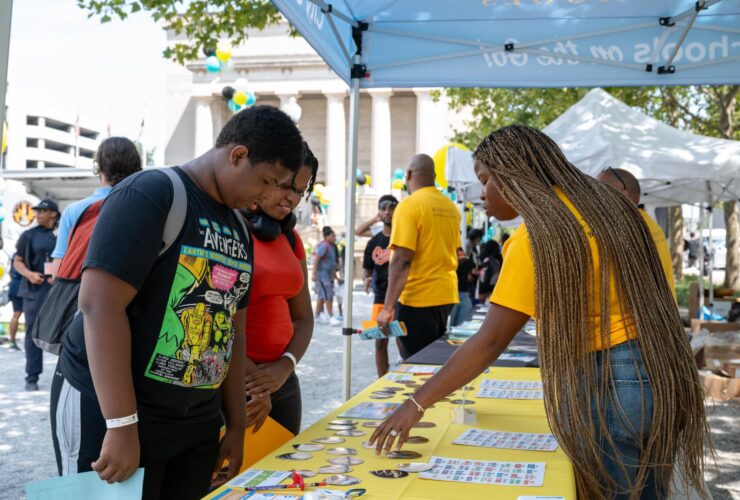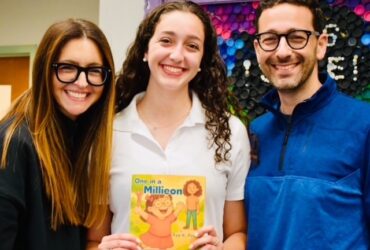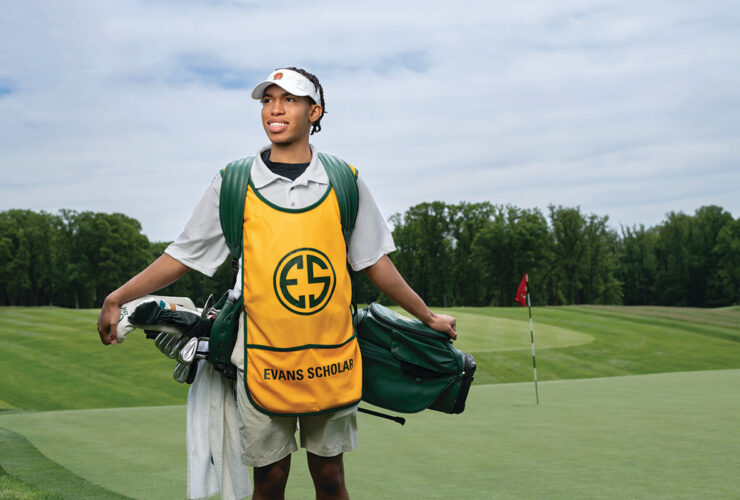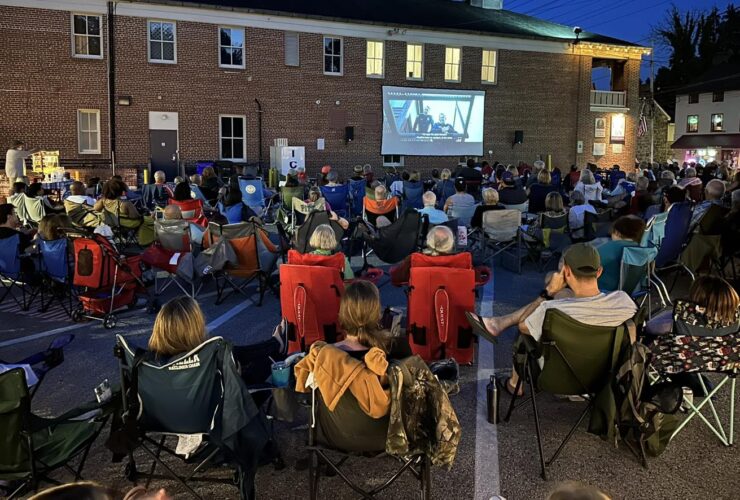Education & Family
All the Right Moves
Chess brightens the futures of Baltimore City public school students.
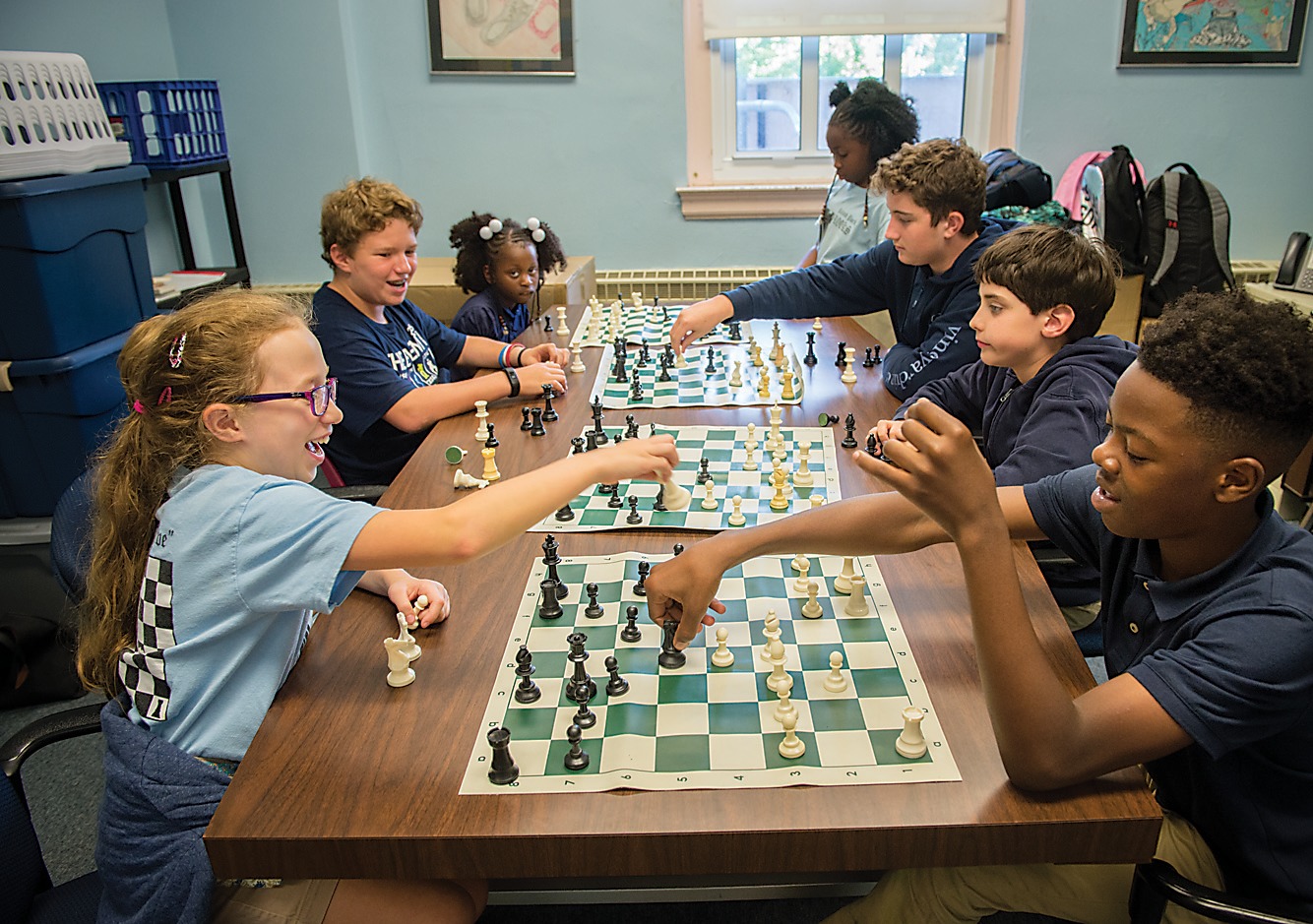
 Cahree Myrick Knows that so much of the game of chess that he loves is psychological. There’s even a mindset about the color of the pieces you commandeer, the 13 year old explains. The player with the white pieces gets to move first, and therefore sets the pace of the game and tends to be more aggressive. But the player with the black pieces has to be deliberate and conscientious to be able to respond to his opponent’s attacks. “Most people like white,” he says. “But some people like to be patient and hold back, and they like black.”
Cahree Myrick Knows that so much of the game of chess that he loves is psychological. There’s even a mindset about the color of the pieces you commandeer, the 13 year old explains. The player with the white pieces gets to move first, and therefore sets the pace of the game and tends to be more aggressive. But the player with the black pieces has to be deliberate and conscientious to be able to respond to his opponent’s attacks. “Most people like white,” he says. “But some people like to be patient and hold back, and they like black.”
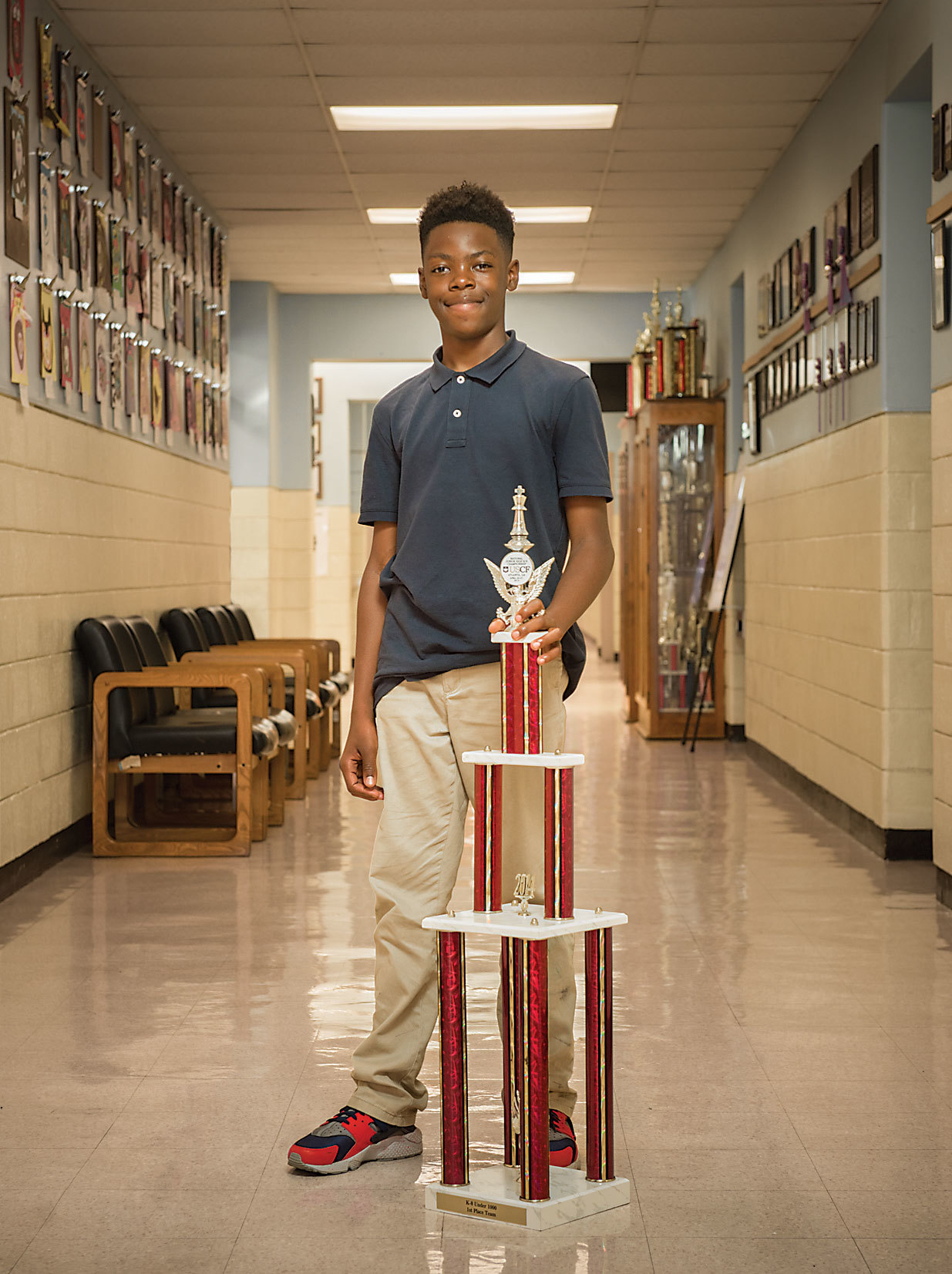
CHAMPION MYRICK WITH A TROPHY.
Away from the board, it’s clear that Myrick relates more to the player with the black pieces. Myrick is equally unflappable when he’s at school or playing with his brothers, says his mother, Yuana Spears. “He’s an old soul. Cahree is extremely laid-back and intellectual. You can tell there’s a lot running through his head, and if you ask him a question, you can see that he’s analyzing it before he responds.”
But when he’s at the chessboard, all that changes, and he assumes the aggressive tendencies more associated with the player moving the white pieces. Like a camera lens, Myrick’s eyes widen and zoom in on the checkered board as he envisions his next trap. The moves he makes are swift, strategic, and deadly, as he offs a knight here, kills a pawn there, always on the hunt for the player with the crown. But at the same time, he understands that he can only really control half of the action. “The game is based off what your opponent does, too,” he says. “You can’t just try to do your original plan if your opponent is doing something that would destroy you.”
Myrick was thinking of that this past May as he sat in the ballroom of a hotel in Nashville, TN. He was similarly focused on a chessboard, playing the last of seven games during the grueling three days that made up the United States Chess Federation SuperNationals, where 5,575 young people competed. But he was down in this game, as he had been in the fifth and sixth games, both of which he thought he might lose, but then rallied to win. He gazed at the board. His opponent, who he thinks was from Texas, was up by a castle-shaped rook and a knight. Myrick knew what he had to do—“keep pushing and pressuring him with different moves, and make him think he was in a position he couldn’t get out of,” he recalls four months later.
the scratching of pencils as the players recorded their moves, or the murmur of voices as opponents asked for bathroom or water breaks. But Myrick knew his teammates from Roland Park Elementary Middle School were close by, silently lending him their support. Though he might not have realized it fully, his coaches and other chess officials back in Baltimore knew the reality of the situation—that Myrick was well positioned to become the city’s first young individual chess champion at a national tournament.
“I might win this,” Myrick thought, but instantly put the idea out of his head. “I told myself that I have a chance, but not to throw it away with one mistake,” he recalls. “I knew that I couldn’t give up.”
MEMBERS OF ROLAND PARK ELEMENTARY MIDDLE SCHOOL’S CHESS TEAM WITH COACH LESA HORNE (TOP ROW, MIDDLE) AND CAHREE MYRICK (TOP ROW, SECOND FROM LEFT).

CROSS COUNTRY THE SCHOOL’S TROPHY CASE IS PROOF THAT IT’S ONE OF BALTIMORE’S CHESS SUCCESS STORIES.
Myrick’s words could very well be the mantra of the Baltimore Kids Chess League (BKCL). The 14-year-old scholastic chess organization includes Roland Park Elementary Middle School, and about 40 other Baltimore City public schools. Keeping chess alive in the city schools has meant staying persistent and not getting discouraged by financial or administrative pressures. “You have to stay the course,” says Steve Alpern, who has headed up the league since the beginning. “And that’s because we know chess is doing something right for these kids beyond the game. Chess gets kids away from the television, but it also teaches habits that come in handy in the real world. You have to play by the rules—you make a mistake, you pay the price, you can’t blame anybody else. And if you keep at it, you get better. Those are rules that the city school kids do not get elsewhere.”
Alpern taught chess for many of the 33 years he spent with Baltimore schools. At one point, he ran an after-school program that focused on the game, but it was cut because of a lack of funding. Then, one day in 2003, a woman came to his office with an idea. Dr. Linda Lee had become intrigued by scholastic chess while on a trip to Houston, but when she returned to Baltimore she was dismayed to find that no such programs existed in her home city. The irony is that Lee is not a chess player herself, and she isn’t a city schools parent—her son went to Friends School, and despite initially wanting to play, he lost interest. But she couldn’t shake the idea, so she enlisted Alpern’s help, and in 2003, they started what would become the BKCL with 60 kids who were in the third and fourth grades at 10 schools. “[Alpern] needed me to help with the logistics, but I needed his help to access the schools,” says Lee, who is a gastroenterologist. “The teachers were so happy because they didn’t have a lot of after-school activities, and they didn’t have a lot of money for them. But chess is so cheap; it was so perfect in that regard.”
Her lack of a personal connection to the city schools didn’t matter to Lee. “I have lived here since 1991, and every day I would get up and go to work and, usually, I would be so tired that I didn’t do anything in the community. I didn’t volunteer,” she says. “It was chess that connected me to Baltimore.”
Alpern praises Lee’s enthusiasm and commitment. “She had no ulterior motive—she just thought it was the right thing to do for the school system. And there’s just so little of that motivation in the world today,” he says. “If people in the community have an idea, they can make it happen. That’s what we learned from this program.”
The chess league grew quickly, adding fifth graders a few years in, then middle schoolers, then second and first graders until it soon spanned all grades, K-12. Financial support from the Abell Foundation and the Johns Hopkins University Center for Talented Youth allowed the program to incorporate 800 children at 40 schools. Now, each school pays $2,000 per year to be part of the league, but they really only have to come up with $1,000 because Abell will match them. That fee gets the schools entry into league-run tournaments, and chessboards, as well as stipends and two training sessions for each of the roughly 40 coaches. Also, part of it pays for member schools to go to state and national tournaments, where participants compete against and meet thousands of other kids just like them.
Lee would like to see the program have an even broader reach. “We are only hitting about a third of the schools in Baltimore,” she says. “In the next five years, I’d like to get 80 percent of schools involved, at least the elementary schools.”
The city’s burgeoning interest in scholastic chess is part of a national trend. In 2012, 127 chess leagues had registered with the U.S. Scholastic Chess Affiliates. By 2017, that number ballooned to 269. Youth chess has received national attention, particularly as it relates to the 1,500-year-old game’s ability to change the lives of children in poor inner-city and rural areas. This spring, the TV news program 60 Minutes featured the story of young chess players in Franklin County, Mississippi, who placed in the top 10 at the national tournament in Nashville. Their coach, Jeff Bulington, who is also noted for teaching chess in Memphis, in one of the country’s most distressed ZIP codes, notes, “[During] my career in teaching chess, people say things like, ‘I did not know that [the student] could do something like that,’ or even something as simple and as crass as, ‘I did not know he was smart or she was smart.’ It tells me some people got it wrong, that some kids have been underestimated or written off for reasons that are false.”
Baltimore’s chess teams have had similar successes. Graduates have received scholarships to Brown University, Goucher College, and The University of Maryland Honors Program at a time when many come for athletes in sports like football and basketball. Three schools have won national championships, and several have placed in the top 10. And, of course, this year there was Cahree Myrick.
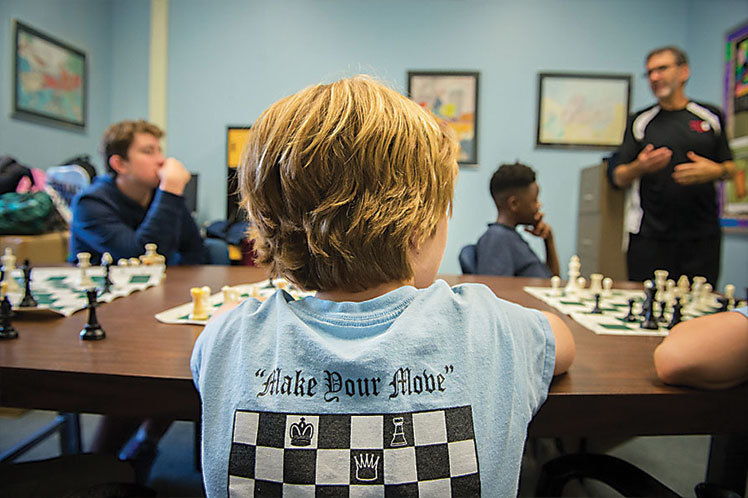
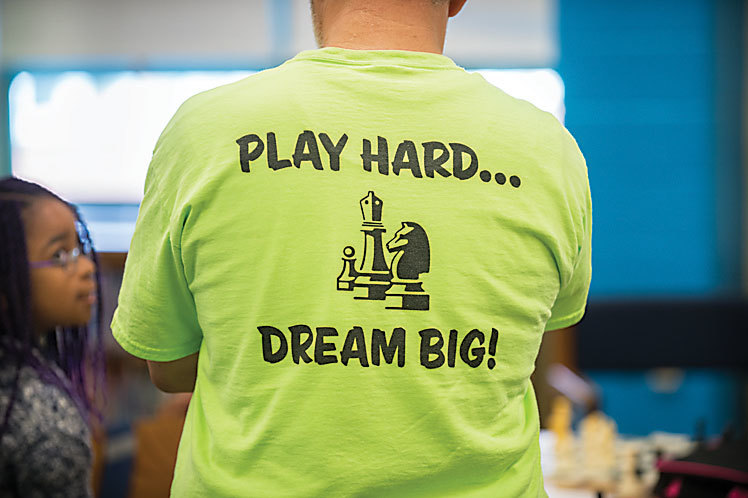
SCENES FROM ROLAND PARK ELEMENTARY MIDDLE SCHOOL's CHESS TEAM PRACTICE and “PLAY HARD. . . DREAM BIG!” T-SHIRT WORN BY KATZ

SCENES FROM ROLAND PARK ELEMENTARY MIDDLE SCHOOL's CHESS TEAM PRACTICE
When he was in first grade, Myrick came home from school with a flyer about the chess club. Spears asked him what he knew about chess. “Cahree said that the pieces looked really cool and that they move in different ways and there’s a king, a queen, and a knight,” Spears recalls. “That’s about all he knew.” But Myrick’s natural talent floored his coaches at The Green School of Baltimore, where he attended elementary school. “They were convinced that we played at home,” Spears says. But that didn’t surprise her—she’d always known her son was special. He’d started school a year early, and once when he was in preschool and she’d taken him to the store to pick out a toy as a reward, he chose a math workbook.
Soon, Myrick was participating in tournaments and playing against anyone he could, from friends and his two younger brothers to guys at the barbershop. He competes online as well, and estimates that he plays about five games a day. Chess was also one of the key reasons why the family picked Roland Park for Myrick’s middle school—it’s one of three local schools to have won a national tournament. In 2016, Myrick got his first big test: He headed off to Nationals in Indianapolis. He’d spent weeks preparing, playing an average of two hours a day, on top of school and track practice. But the family is used to hard work and sacrifice. Before she married her husband—the man Myrick identifies as his father—when Myrick was 6, Spears worked two 10-hour days and two 14-hour nights at the Baltimore County Fire Service, as well as a part-time job, each week, all while attending school.
“I didn’t want to take away the time I got to spend with Cahree, so my part-time job was overnight while he was asleep,” she says. “Whatever extracurriculars I could afford, I put him in. If that meant I had to pick up another shift so that he could be exposed to a different type of lifestyle, then I did that.”
When Spears talked to him on the phone in Indianapolis, Myrick said, “Mom, I didn’t do so well.” He placed 24th out of 284 players in his division, and “there were some games I knew I could have won, but I messed up, and that was upsetting,” Myrick says. “This year, I had more practice and experience, and I knew I had to work harder.”
In 2017, the SuperNational tournament was over Mother’s Day weekend, and this time Spears was at her son’s side. She waited anxiously in the lobby outside the ballroom with the other parents as the games stretched on—Myrick’s longest was three hours. On the last day, she was talking with another parent when she realized that Myrick had sat down next to her and was playing on his phone. Then one of his coaches came over and asked how he’d done. Myrick said, simply, “I won.”
“Just like nothing had happened,” his amazed mother recalls. “And I was like, ‘You won? You just won your division?’ And he was like, ‘Yep.’” He was the only player in his division to win all seven games—a perfect score.
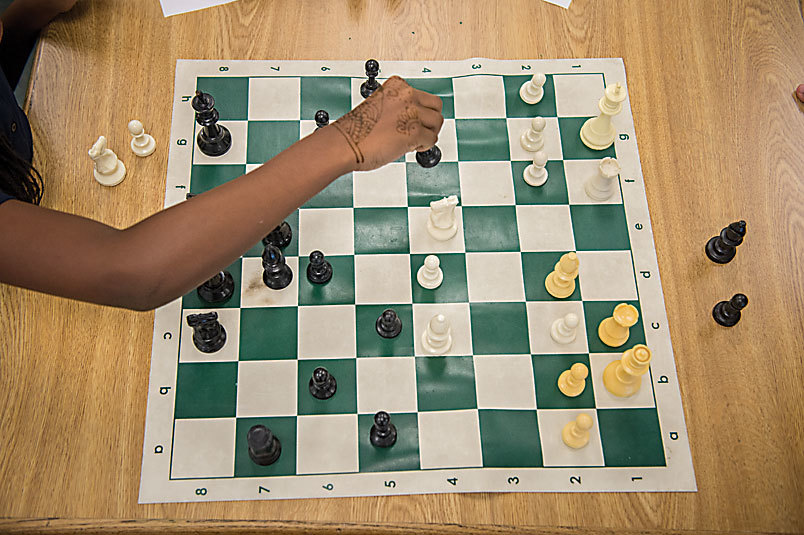
A GAME IN PrOGRESS ON A PRACTICE BOARD at ROLAND PARK ELEMENTARY MIDDLE SCHOOL.
Myrick displayed similar stoicism when, wearing his Under Armour sweatshirt and slide-on sandals with socks, he received the shimmering trophy that reached up to his waist. Someone snapped a picture of him that was soon making the rounds on social media. The family returned home to much fanfare—there were meetings with the mayor, letters of support from congressmen, stories on local TV stations and in The Sun. He faced off against six Orioles players, including Manny Machado, and beat them all. The University of Maryland, Baltimore County, which has a champion chess team of its own, offered Myrick a full scholarship, as did Morgan State University.
Spears can think of one moment when reality seemed to set in. The family was driving back from playing the Orioles when Myrick asked his mom to turn down the radio. “And he said, ‘Hey ma, you know I took first place in my division?’ And I said, ‘Yeah, kid, I’m so proud of you.’ He was like, ‘I have two college scholarships and I’m 12,’ and we all screamed, even the 4 year old. The other cars were probably looking at us like we were crazy,” Spears says. “He is an amazing kid all around, and nobody can ever take that from him.”

A GAME IN PrOGRESS ON A PRACTICE BOARD at ROLAND PARK ELEMENTARY MIDDLE SCHOOL.
On a Tuesday afternoon in September, as big yellow school buses shuttle children in uniforms back home, a small group gathers in the library at Cross Country Elementary Middle School in Northwest Baltimore. They sit in chairs in front of a large, hanging chessboard with plastic slots that hold cards that resemble chess pieces, from the king to the pawns.
“When you are in check, you have to do what first, before you can do anything else?” asks Daniel Katz, the man standing at the front of the room, who has been the coach of the chess team since the beginning of the Baltimore Kids Chess League.
“You have to move your king,” says Immanuel Korir, whose soulful eyes and quiet maturity belie his 12 years.
“That’s right, you have to get out of check first,” Katz answers.
These basic questions are an indication that it is the start of a new season and a new team at Cross Country, which is considered one of Baltimore’s chess success stories. The team has been to the national championships numerous times, placing in the top 10 several times, and four trophy cases in the school’s lobby hold the spoils of countless wins.
Korir was one of the students who went to the national tournament last year. “Chess makes me think longer about things, helps me make good decisions,” he says as the group pairs up and rolls out canvas mats that are printed with chess boards. Once, he says, “I had a group of bad friends that were trying to steal something in the school and I said, no, it wasn’t a good idea.”
Hearing that kids apply the mature consideration chess develops to their own lives is one of the ways Katz measures his program’s success. “I definitely see in many children a level of thinking skills, a level of planning ahead, that I didn’t necessarily see before,” he says. “When they explain something that they just did on the chessboard, I can see a lot of growth, and I think that translates into other areas.”
The next day, at Roland Park Elementary Middle School, it’s Myrick who’s sitting in front of the hanging chessboard, along with some of his chess teammates. This time, Steve Alpern has stopped by to teach a lesson, and the questions and terms are a little more complex, as these are the advanced players. They discuss “discovered attacks” and “openings”—the beginning moves of the game—and then Alpern has them map out a chess game. When Myrick describes his plan of attack, Alpern steps back in surprise. “That’s thinking three to four moves ahead,” he exclaims, obviously impressed with Myrick’s strategy.
Now that he’s in eighth grade, Myrick is thinking ahead as well—he’s looking at Baltimore Polytechnic Institute for high school, and considering engineering for a career. Spears knows that the skills her son has acquired at the board will serve him well. “He knows that everything is not going to be easy, and that he will forever have a challenge,” she says. “Just like life.”

